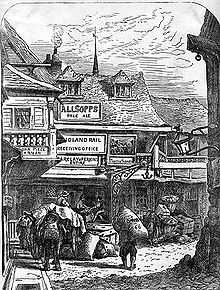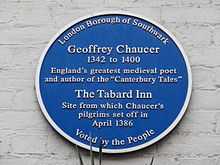The Tabard

The Tabard was a historic inn that stood on the east side of Borough High Street in Southwark. The hostelry, which was first established in 1307, stood on the ancient thoroughfare that led south from London Bridge to Canterbury and Dover. It was built originally for the Abbot of Hyde who purchased the land to construct a place to stay for himself and his ecclesiastic brethren when on business in London.
The Tabard was also famous for accommodating the numerous pilgrims taking the annual pilgrimage to the Shrine of Thomas Becket in Canterbury Cathedral. It is mentioned in Geoffrey Chaucer's 14th Century work The Canterbury Tales. The inn, which was clustered around a yard, was entered through a gateway off the high street.
History

The inn, which was located in Southwark on the southern shore of the River Thames, was located on Borough High Street just north of where the two Roman roads of Stane Street and Watling Street merged. It stood near the Manor of Southwark - medieval London's entertainment district - and controlled by the Bishops of Winchester. Also known as the Liberty of Winchester, it lay outside the jurisdiction of the City of London. In these times, the Tabard would have been filled with pilgrims, drunks, travellers, criminals, and prostitutes (colloquially known as the "Winchester Geese"). Activities that were forbidden within the 25 wards of the City of London and the county of Surrey were permitted within Southwark. The most common being prostitution and live animal baiting.
Chaucer wrote that The Tabard was the location where the pilgrims first meet on their journey to Canterbury in the 1380s. The inn's proprietor was a man named Harry Bailey:[1]
Bifel that in that season on a day,
In Southwerk at the Tabard as I lay
Redy to wenden on my pilgrymage
To Caunterbury with ful devout corage,
At nyght was come into that hostelrye
Wel nyne and twenty in a compaignye
Of sondry folk, by aventure yfalle
In felaweshipe, and pilgrimes were they alle,
That toward Caunterbury wolden ryde;
The chambres and the stables weren wyde,
And well we weren esed atte beste;
The antiquary John Stow wrote in his Survey that by the 16th Century it was among several inns at this location in Southwark: "many fair inns, for receipt of travellers, by these signs: the Spurre, Christopher, Bull, Queen's Head, Tabard, George, Hart, King's Head" &c.[2] Following the Dissolution of the Monasteries in the mid 16th Century, "the Tabard of the Monastery of Hyde, and the Abbot's Place, with the stable and gardens thereunto belonging" were sold to John and Thomas Master.
On 26 May 1676, ten years after the Great Fire of London, a great blaze started in Southwark. The Tabard was among many buildings that were either burned down or pulled down to create fire breaks. The blaze, which took 17 hours to contain, destroyed most of medieval Southwark. King Charles II and his brother the Duke of York were both involved in the firefighting effort. Although the medieval building was destroyed, the site was immediately rebuilt and renamed The Talbot.
In the early 18th Century, the new inn was profiting from the growth in stagecoach traffic between London and the channel ports because of the growth in turnpikes. By the early 19th Century, the Talbert remained a well-renowned coaching inn. However with the advent of the railways, it eventually closed. The building was then converted into stores. It was demolished in 1873.
Memorial
The Tabard was situated to the east of Borough High Street next door to The George (itself one of London's oldest public houses) in Talbot Yard. On 23 November 2003, a blue plaque was installed on the wall of Copyprints Ltd, the oldest building in Talbot Yard, describing the historical significance of the Tabard Inn and celebrating Southwark's cultural links with Geoffrey Chaucer. It was unveiled by former Python and medieval enthusiast Terry Jones.
Notes
- ↑ Southwark: Famous inns, Old and New London: Volume 6 (1878), pp. 76–89, accessed: 16 June 2008
- ↑ Quoted in Walter Thornbury and Edward Walford, Old and New London: A Narrative of Its History, Its People and Its Places (London) 1893:76.
External links
- The Tabard Inn in Southwark, another nineteenth-century engraving